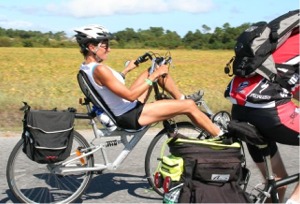Postural orthostatic tachycardia syndrome facts for kids
Postural orthostatic tachycardia syndrome (POTS) is a medical condition. When someone has POTS, their heart beats much faster than normal when they stand up. POTS can also cause many other symptoms.
Contents
What are the Signs and Symptoms of POTS?
When a healthy person stands up, their heart beats a little faster for a short time. This helps push blood to the brain. Then, their heart rate goes back to normal.
If someone has POTS, their heart beats much faster than normal when they stand up. Doctors diagnose POTS when a person's heart rate increases by at least 30 beats per minute within 10 minutes of standing. This is called postural tachycardia.
People with POTS also have other symptoms that get worse when they are standing. These symptoms get better when they lie down. This is called orthostatic intolerance. These symptoms can include:
- Feeling their heart pounding (palpitations)
- Feeling dizzy, fainting, or almost fainting
- Chest pain
- Trouble breathing, especially when exercising
- Feeling very weak or tired
- Blurred vision (not seeing clearly)
- Headache
- Trouble concentrating or thinking
- Nausea (feeling sick to your stomach)
- Trouble sleeping
- Pale skin (pallor) or sweating a lot
Symptoms might get worse if a person with POTS:
- Sits for a long time
- Stands for a long time
- Drinks alcohol or caffeine
- Gets too hot
- Exercises too much
- Eats a very large meal
What Causes POTS?
Many different things can cause POTS. Scientists are still learning about many of these causes.
Some known causes of POTS include:
- Genetics: It can sometimes run in families.
- Getting sick with a virus: Sometimes POTS starts after a person has been sick with a virus.
- Chronic diabetes: This is a long-term health problem that affects blood sugar.
- Hypovolemia: This means not having enough blood or fluid in the body. When this happens, less blood gets to the heart. The body tries to fix this by making the heart beat faster.
- Nerve problems: Sometimes, the nerves in the lower legs don't work right. This can cause blood to collect in the legs. The body tries to fix this by making the heart beat faster to push blood to the rest of the body.
POTS is more common in:
- Girls and women, especially between the ages of 15 and 50.
- People who have had to rest in bed for a long time.
- People who have certain other health conditions, like autoimmune diseases (where the body's immune system attacks itself).
How is POTS Treated?
There are many ways to help with the symptoms of POTS. Some common treatments include:
- Drinking a lot of water: This increases the fluid in the body, helping blood get to the heart more easily.
- Eating more salt: This helps the body keep fluid, which can stop people with POTS from getting dehydrated.
- Getting exercise: Special exercises like recumbent bicycling (bicycling while lying back) can help. This prevents symptoms that happen from being upright.
- Using compression stockings: These are very tight socks that help stop blood from collecting in the legs.
- Avoiding triggers: It's important to avoid things that make POTS worse, like getting dehydrated, exercising too much, eating large meals, drinking alcohol, or getting too hot.
No medications have been officially approved by the United States Food and Drug Administration just for POTS. However, doctors sometimes use medicines that:
- Stop the body from losing salt.
- Raise blood pressure.
- Keep the heart from pumping too fast.
Can People Recover from POTS?
Most people with POTS can get better with treatment. About 6 out of every 10 people with POTS improve within 5 years of being diagnosed. About 9 out of every 10 people with POTS feel some improvement with a mix of physical treatments and medicines.
However, some people with POTS do not get better, and their symptoms might even get worse over time.
Related pages
Images for kids
See also
 In Spanish: S%C3%ADndrome de taquicardia ortostática postural para niños
In Spanish: S%C3%ADndrome de taquicardia ortostática postural para niños



